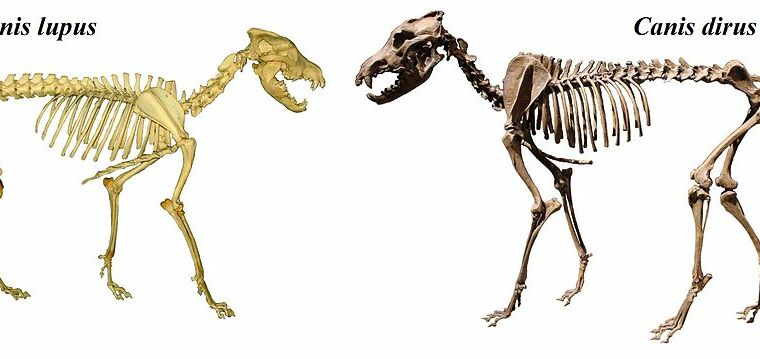
Terrible wolves had a wave of newly discovered fame with their appearance in Game of thronesThey are portrayed as a much larger version of earthly wolves. Here in the real world, only the largest number of wolves nowadays can reach the size of a terrible wolf, which weighs nearly 70 kilograms. These animals once shared in North America – and possibly prey – with predators such as the smilodon, a cat with sword teeth. Before the arrival of humans, dire wolves were more common than regular wolves, as evidenced by the remains found in the La Brea tar spills, where gray wolves outnumber around 100.
Like the smilodon and many other large mammals in North America, the dire wolf disappeared during the period of climate change and the arrival of humans on the continent, even as gray wolves and wolves still survived. As they were gone, they left a little mystery behind: What were they?
A new study uses ancient DNA from dire wolf skeletons to determine that they were not, in fact, wolves and have been genetically isolated from them for millions of years.
It’s like a wolf, but …
When it comes to dogs, species boundaries and their relationship to anatomy are vague. Domesticated dogs have incredibly varied shapes, yet they are part of one species and can still mate with the gray wolves that they originated from. Gray wolves and coyotes can also mate. So the question of whether gray wolves and dire wolves are closely related, as suggested in their similar appearances, will also hint at whether the terrible wolf has made genetic contributions to any current species.
The new work, by a major international collaboration (full disclosure: I was climbing rocks with one of the authors) began with traditional means to try to answer this question: by looking at the skeletons of terrible wolves. But this analysis, which included more than 700 individual skeletons, didn’t produce much. Although the two were sufficiently different that the two species could be stably recognized, there were no significant differences indicating a significant evolutionary distance.
So the team switched to more modern methods. It is possible to isolate parts of collagen, which is a protein that is a major component of bone and often has subtle differences between types. The terrible wolf collagen sequence had enough variations to indicate that the dire wolves were closely related to several modern canine-like species. But the similarities between all of them were high enough to prevent researchers from unraveling relationships between these species.
Then, the team began isolating DNA from the remains and were able to obtain some of them from five samples, coming from all over the United States, from Idaho to Tennessee. The ages of the skeletons ranged from 13,000 to over 50,000 years old. Shorter mitochondrial genome analysis yielded similar results for collagen. He noted that dire wolves were a distinct breed that were far from wolves and coyotes, but that the analysis was confused by the small differences between the species and the fact that some subspecies (such as wolves and coyotes) had interbreed.
Near far
Leave that analysis based on normal nuclear genome sequences. Due to the age of the samples, the DNA was severely damaged and only a small portion of the entire genome of the animals was produced (only 1 to 20 percent of the genome was obtained, depending on the sample). To fully explore the dog breed, the researchers also obtained genome sequences from a North American wolf and two jackals – most other species were arranged in this branch of the evolutionary tree.
The tree based on these sequences indicates that the last species of foxes diverged from the rest of the dog species about 7 million years ago. The next branch, which occurred about 6 million years ago, produced a branch that included both the jackal and the terrible wolf. Everything else, including African wild dogs, various wolf species, and the wolf, were all in a separate branch of lineage and more closely related to each other than the terrible wolf.
There is a fair amount of uncertainty here, as is usually the case in evolutionary sequence analyzes; The split between the terrible wolf and the other major branch could occur anywhere from 4 to more than 8 million years ago. But it is evident that despite the physical similarities between dire wolves, they are part of a distinct breed that is only distantly related to dogs.
Given that other dog species appear to have engaged in near-regular crossbreeding, researchers have checked for signs of this here. This analysis showed that there is no clear indication that dire wolves have interbreed with wolves or coyotes, despite having shared a continent for several thousand years. There is a hint at the possibility that the ancestors of dire wolves mated with ancestors of wolves, coyotes, and hatchlings somewhere around 3 million years ago, but the indication for this is rather weak.
Overall, this finding is interesting as a fact in itself. A few generations of Dungeons and dragons Guys might have been told that a terrible wolf is a really big wolf, and we now know that that’s wrong. But it would also likely push us back and rethink some of the fossils we’ve had for years. We have a number of North Americans that have been interpreted on the basis that all types of dogs on the continent were part of a group of closely related species. Now that we know that there are two very different lineages here, we can go back and try to determine if any of the ancient fossils are closely related by one lineage or the other.
Nature, 2021. DOI: 10.1038 / s41586-020-03082-x (About DOIs).

“Appassionato di alcol. Piantagrane. Introverso. Studente. Amante dei social media. Ninja del web. Fan del bacon. Lettore”.

